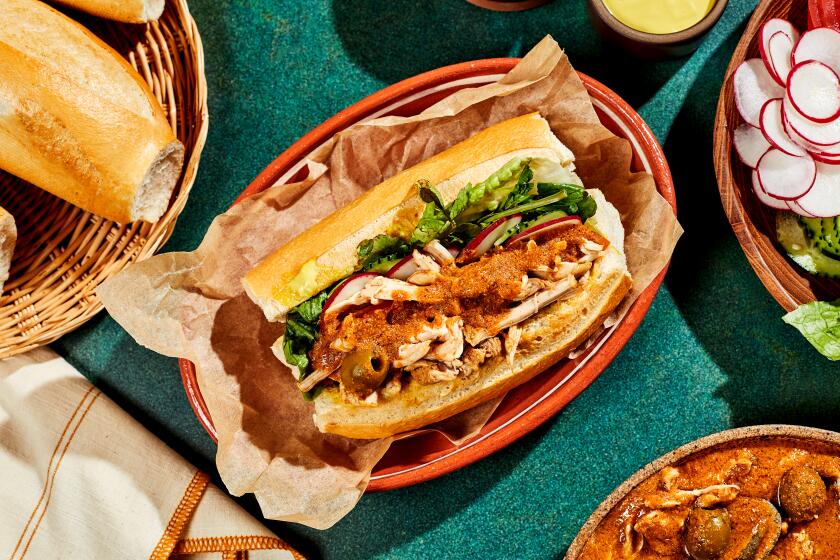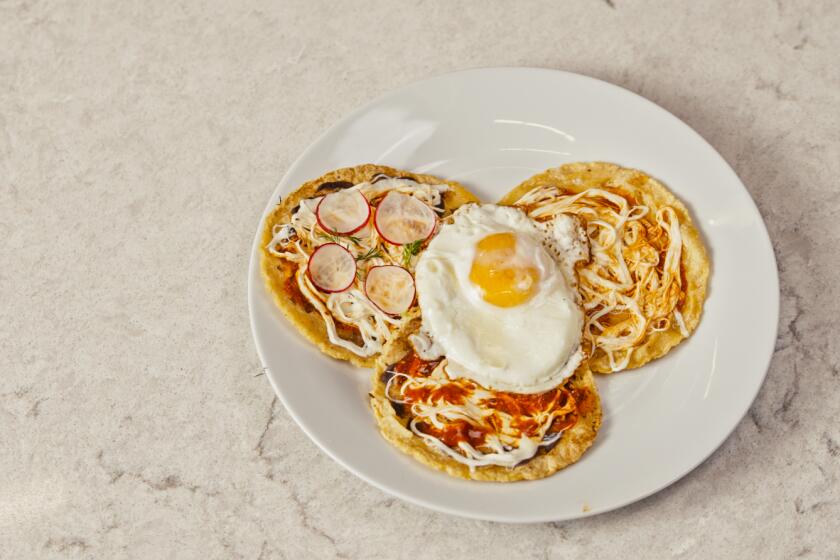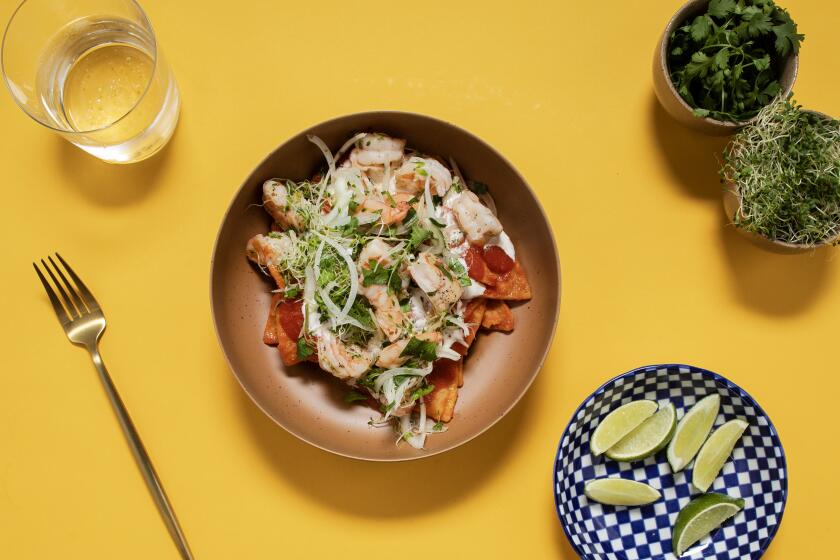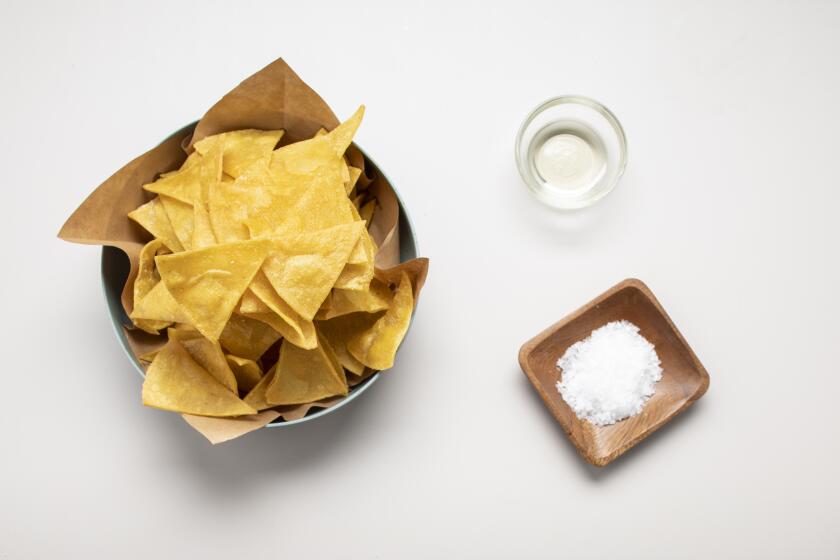Whole wheat cinnamon rolls

- Share via
Imagine the landscape of a weekend morning, maybe the early hours of an Easter Sunday before whatever ritual -- your church, my egg hunt -- you observe. The house asleep, the alchemy of coffee, the knead and rise of dough. Fingerprints of flour on your coffee cup like evidence. After a few hours, mostly spent in the downtime of rising or baking, you open the oven door. Pull out the tray of cinnamon rolls, redolent of spice and sugar and yeast, turned gold by the heat that still warms the kitchen.
Sure, you can buy cinnamon rolls, sometimes even very good ones, at your local bakery, in the neon funhouse of the mall, in the bread aisle of grocery stores. But the homemade version is an exponential improvement, the spirals of pastry and spice, latticed with icing, unrolling more than just breakfast. With an easy recipe, you can create the comfort zone of a happy morning, a family breakfast table, a special holiday brunch.
Cinnamon rolls, like other essential comfort foods, are subject to their own iconography. Maybe your mother’s recipe. Or the rolls the size of hubcaps, loaded with enough cream cheese frosting to mortar a building, that you keep returning to -- a Midwestern diner, a Colorado truck stop -- as if to the scene of a crime.
And they fall into two basic categories: the cinnamon roll as viennoiserie, made with croissant dough, the layers of embedded butter creating a rich, flaky archaeology; and the cinnamon roll as sweet bread, more like a spice-shot spiral of brioche. Making the former is possible, but it helps if you have a patisserie degree, and your best bet is probably to secure a permanent table at your local bakery.
Making the latter category of cinnamon rolls is not only possible but downright easy. You mix up the dough, let it rise, roll it out and then up, with a bit of filling. After another rise -- most of which can happen overnight in the refrigerator -- you slide them into the oven. Twenty minutes later, you’re done. A drizzle of icing. Your kitchen fragrant with cinnamon.
This kind of cinnamon roll is what most of us grew up with, more a cinnamon bun than a Danish, a soft spiral that can accommodate vast quantities of cinnamon and icing but that isn’t so rich that a few of them can’t be consumed with a cup of coffee.
The key is to start with a basic sweet bread dough. This dough, enriched with butter and sugar, eggs and buttermilk, can be used for other things too: braided into challah, studded with raisins and baked into a loaf, portioned into monkey bread.
Add a little cinnamon to the dough too. Food scientist Shirley Corriher, in her most recent book “BakeWise,” notes that a small amount of certain spices, including cinnamon, enhances yeast activity. Even if the cinnamon doesn’t leaven the dough much -- the additional yeast that enriched sweet dough requires accomplishes this -- it will add another layer of spice to the finished product. A bit of baking soda added to the mix sweetens the dough and neutralizes the acidity of the buttermilk (thanks to baker Peter Reinhart for that pointer).
Although you can knead the dough by hand, making this recipe in a mixer fitted with a dough hook is a lot easier. After five minutes in the machine, turn the dough out into a buttered bowl to rise for an hour, then you’re ready to, um, roll.
What you put into cinnamon rolls can vary enormously. After you’ve rolled the dough out into a rectangle and brushed it with melted butter (this binds with the small amount of flour in the filling and keeps the cinnamon-sugar from spilling out), you can spread the traditional cinnamon-sugar over the dough. Or you can experiment a bit, using candied ginger, chopped nuts, other spices -- cardamom is a favorite of the Scandinavians who popularized cinnamon rolls -- or even a few spoonfuls of jam.
Although you’d think that raisins or other dried fruit would be a great idea, save those for the bread you make with the same sweet dough recipe. Because though the raisins inside the rolls remain plump, the ones on the tops are exposed to too much heat during baking and tend to burn.
A few more tips: Add a pinch of salt to the filling to bring out the flavor. And be careful not to roll up the filling and dough too tightly, as tight rolls will often burst during that last quick rise in the hot oven.
After you’ve loosely rolled up the dough and filling -- this is kind of like making a jelly roll -- and pressed the edges together, cut the rolls with a bit of dental floss or kitchen twine (don’t use flavored dental floss!) instead of a knife. This may sound odd, but it’s a trick used in culinary school baking classes and by the ultimate authority, Martha Stewart, to ensure that the spirals of dough aren’t smashed.
After another hour of rising time, the rolls are ready to be baked, cooled and frosted. Alternatively, you can wrap the tray of rolls with plastic wrap and put them in the refrigerator. The next morning, just take the tray out of the oven about 90 minutes before you want to serve them. Let them rise for an hour, then into the hot oven they go.
However, if you want a highly nutritious breakfast, you might try to make granola instead of cinnamon rolls. That said, you can try making whole wheat cinnamon rolls.
By switching out half of the all-purpose flour with whole wheat flour (more than that and the dough becomes too dense), you get the benefit of whole grains without changing the ontological properties of a favorite breakfast indulgence.
With the whole wheat, there’s a little more buttermilk, a little more cinnamon. But the major difference is that there’s a 15-minute resting time added to the mixing process. (Go away, read the paper.) This resting time, called an autolyse, allows the gluten in the flour to develop, and effectively creates a softer dough than you would have had without it.
After that, the recipe proceeds the same as the regular recipe. The end result is much the same too, but with the added flavor -- which combines beautifully with the spice, as well as with nuts, ginger or blackberries.
After you master a basic recipe, making cinnamon rolls becomes not only easy but easily repeatable -- even when it’s not a holiday. Bake a tray of traditional rolls for breakfast (invite your mother), or branch out and make ginger rolls for a more impressive brunch affair. No malls, no truck stops, no jelly beans necessary, just the spice route to your kitchen.
In a small bowl, whisk together the buttermilk, orange zest and eggs. Set aside.
In the bowl of a standing mixer fitted with a dough hook, add the wheat flour, all-purpose flour, sugar, yeast, baking soda, three-eighths teaspoon cinnamon, 1 ¼ teaspoons salt and the softened butter. Pour in the buttermilk mixture and mix over low speed until the mixture comes together, about 1 minute. Place a towel over the top of the mixture and set it aside to rest for 15 minutes.
Increase the speed to medium and continue to mix until the dough pulls away from the sides of the bowl, about 5 minutes, adding a little flour if the dough is too wet (up to one-quarter cup).
Scrape the dough from the bowl and form it into a ball — it should be very soft, like brioche dough — and place the dough in a large, buttered bowl. Cover with plastic wrap and set aside in a warm place until doubled in volume, about 1 hour.
While the dough is rising, make the filling. In a small bowl, sift together the brown sugar, remaining 2 tablespoons cinnamon, 1 tablespoon all-purpose flour and 1 teaspoon salt.
When the dough is risen, remove it to a well-floured work surface. Roll the dough into a rectangle one-fourth inch thick, and approximately 17 inches long and 12 inches wide. Brush the dough with one-fourth cup (4 tablespoons) melted butter, then sprinkle the cinnamon sugar mixture over it, keeping 1 inch clear along one of the long edges. Loosely roll the dough into a long tube, pressing the clear edge along the length of the dough to seal the tube. Place the tube, seam-side down, on the work surface.
Cut the tube crosswise into 12 evenly sized rolls using a length of unflavored floss (slide the floss under the roll and then pull both ends tight, which doesn’t squash the dough as much as a knife would). Place the rolls, spiral side up, on a parchment-lined baking sheet, spaced approximately one-half inch apart.
Cover the rolls loosely with plastic wrap and set aside until almost doubled in size, about 1 hour. Half an hour into the rise, heat the oven to 375 degrees.
Bake the rolls until puffed and golden brown, about 20 to 25 minutes. Remove from the tray and cool on the parchment paper.
Meanwhile, make the icing: In a medium bowl, whisk together the powdered sugar, orange juice, milk, remaining 2 tablespoons melted butter and a pinch of salt. The icing should have the consistency of very thick syrup, add additional milk or sugar as needed to adjust the consistency. Ice the rolls by dipping a whisk into the icing and drizzling over the rolls. The rolls can be iced either warm (the icing will melt and spread a bit) or cooled.
Walnut-cardamom rolls: Instead of filling the rolls with the cinnamon sugar, combine 1 cup of finely chopped walnuts, 1 teaspoon of freshly ground nutmeg, 1 teaspoon of ground cardamom, 1 cup of brown sugar, 1 tablespoon of all-purpose flour, and 1/2 teaspoon salt together in a small bowl. Spread the rolled-out dough with the nut mixture and bake as directed.
Ginger rolls: Instead of filling the rolls with cinnamon sugar, combine 3/4 cup of brown sugar, 1/2 cup of minced candied ginger, 1 tablespoon of freshly ground ginger, 1 teaspoon of dried ginger, 1 tablespoon of all-purpose flour, and 1/2 teaspoon salt together in a small bowl. Spread the rolled out dough with the nut mixture and bake as directed.
Get our Cooking newsletter
Get a taste of Los Angeles — and the world — with recipes and kitchen tricks from the L.A. Times’ Cooking newsletter.
You may occasionally receive promotional content from the Los Angeles Times.
















